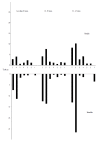Socio-demographic factors related to periodontal status and tooth loss of pregnant women in Mbale district, Uganda
- PMID: 19615094
- PMCID: PMC2722607
- DOI: 10.1186/1472-6831-9-18
Socio-demographic factors related to periodontal status and tooth loss of pregnant women in Mbale district, Uganda
Abstract
Background: Information on the socio-behavioral distribution of periodontal status and tooth loss in pregnancy emanating from sub Saharan Africa is sparse. This study examined periodontal status and tooth loss in pregnant Ugandan women and assessed the relationship with socio-demographics factors, parity, dental care and oral hygiene.
Methods: Mothers were participants of a multicentre cluster-randomized behavioral intervention study (PROMISE-EBF Safety and Efficacy of Exclusive Breast feeding Promotion in the Era of HIV in Sub-Saharan Africa). In Uganda, these were pregnant women resident in Mbale district, recruited into the PROMISE EBF study between January 2006 and June 2008. A total of 886 women were eligible to participate of whom information became available for 877 (participation rate 98.9%, mean age 25.6) women who participated in the recruitment interview and 713 (mean age 25.5) women who got a clinical oral examination. Periodontal status was assessed using the Community Periodontal Index of Treatment Needs (CPITN).
Results: The prevalence of tooth loss was 35.7%, 0.6% presented with pockets shallow pockets (4-5 mm), whereas 3.3% and 63.4% displayed bleeding and calculus, respectively. A total of 32.7% were without any sign of periodontal disease. Binary logistic regression analyses revealed that older women, women from larger households and those presenting with microbial plaque were respectively, 3.4, 1.4 and 2.5 times more likely to have CPI score >0. Rural (OR = 0.9), nulliparous (OR = 0.4) and women who never visited a dentist (OR = 0.04) were less likely, whereas women from larger households (OR = 1.5) were more likely to have lost at least one tooth.
Conclusion: The results revealed moderate prevalence of bleeding and tooth loss, high prevalence of calculus, low frequency of pockets 4-5 mm. Disparity in pregnant women's oral health related to parity suggests that education of maternity care providers concerning oral health in pregnancy is warranted.
Trial registration: ClinicalTrials.gov Identifier NCT00397150.
Figures
Similar articles
-
Periodontal status, tooth loss and self-reported periodontal problems effects on oral impacts on daily performances, OIDP, in pregnant women in Uganda: a cross-sectional study.Health Qual Life Outcomes. 2009 Oct 14;7:89. doi: 10.1186/1477-7525-7-89. Health Qual Life Outcomes. 2009. PMID: 19828031 Free PMC article. Clinical Trial.
-
Determinants of periodontal health in pregnant women and association with infants' anthropometric status: a prospective cohort study from Eastern Uganda.BMC Pregnancy Childbirth. 2012 Sep 5;12:90. doi: 10.1186/1471-2393-12-90. BMC Pregnancy Childbirth. 2012. PMID: 22950749 Free PMC article.
-
Impact of periodontal conditions on the quality of life of pregnant women: a cross-sectional study.Health Qual Life Outcomes. 2015 May 28;13:67. doi: 10.1186/s12955-015-0267-8. Health Qual Life Outcomes. 2015. PMID: 26018650 Free PMC article.
-
[Current status of the female condom in Africa].Sante. 1997 Nov-Dec;7(6):405-15. Sante. 1997. PMID: 9503499 Review. French.
-
The global burden of periodontal disease: towards integration with chronic disease prevention and control.Periodontol 2000. 2012 Oct;60(1):15-39. doi: 10.1111/j.1600-0757.2011.00425.x. Periodontol 2000. 2012. PMID: 22909104 Review.
Cited by
-
Nomogram prediction for periodontitis in Chinese pregnant women with different sociodemographic and oral health behavior characteristics: a community-based study.BMC Oral Health. 2024 Aug 4;24(1):891. doi: 10.1186/s12903-024-04640-9. BMC Oral Health. 2024. PMID: 39098909 Free PMC article.
-
The prevalence and socio-behavioural and clinical covariates of oral health related quality of life in Ugandan mothers with and without HIV-1.Health Qual Life Outcomes. 2021 Aug 23;19(1):201. doi: 10.1186/s12955-021-01844-3. Health Qual Life Outcomes. 2021. PMID: 34425825 Free PMC article.
-
Prevalence of Periodontitis and Associated Factors among Pregnant Women: A cross sectional survey in Southern Province, Rwanda.Rwanda J Med Health Sci. 2021 Apr 8;4(1):131-150. doi: 10.4314/rjmhs.v4i1.10. eCollection 2021 Apr. Rwanda J Med Health Sci. 2021. PMID: 40666399 Free PMC article.
-
Oral Health Status and Treatment Needs among Pregnant Women of Raichur District, India: A Population Based Cross-Sectional Study.Scientifica (Cairo). 2016;2016:9860387. doi: 10.1155/2016/9860387. Epub 2016 May 12. Scientifica (Cairo). 2016. PMID: 27293984 Free PMC article.
-
Oral and periodontal assessment at the first trimester of pregnancy: The PERISCOPE longitudinal study.Acta Obstet Gynecol Scand. 2023 Jun;102(6):669-680. doi: 10.1111/aogs.14529. Epub 2023 Apr 26. Acta Obstet Gynecol Scand. 2023. PMID: 37101411 Free PMC article.
References
Associated data
LinkOut - more resources
Full Text Sources
Medical


